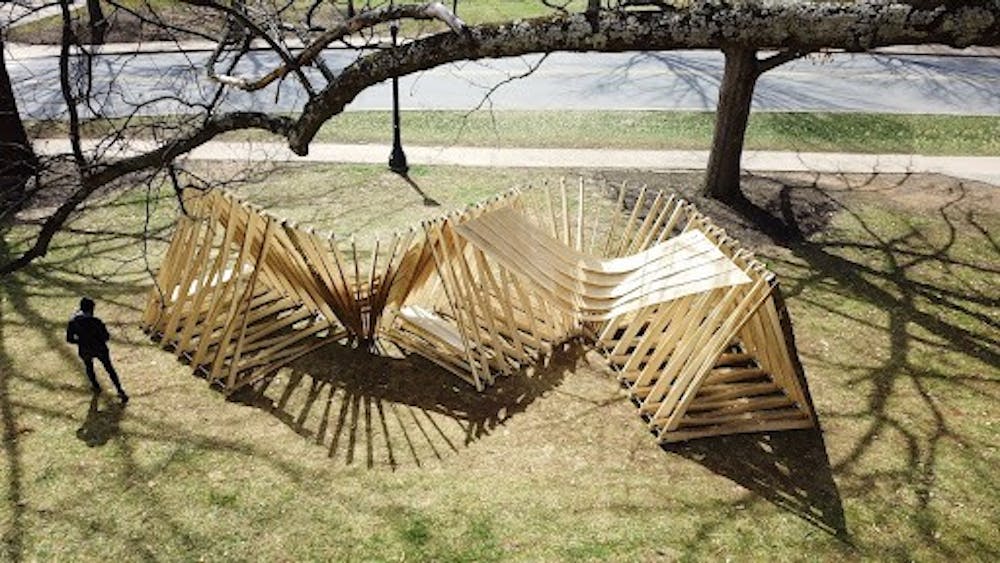Students and University members may have noticed a handful of abstract structures popping up around Grounds throughout the spring. These structures were public exhibits — parts of a larger project by Architecture students and professors in collaboration with architects across the country who hope to reinvent construction norms. The exhibits came to a close recently after decorating Grounds for nearly a month.
The Biomaterial Building Exposition was created by Asst. Architecture Profs. Katie MacDonald and Kyle Schumann, who also serve as curators of the project. MacDonald and Schumann conceived the idea for the project and worked together on fundraising, collaboratively putting together a group of contributors, designing a January Term course for the project and organizing the on-Grounds exposition itself.
“We were interested in how we could create dialogue around biomaterials here at U.Va,” MacDonald said. “In particular, we’re interested in how we can contribute to the circular economy and make building materials that not only sequester carbon but also are able to be decommissioned for decomposition or reuse at the end of their lifecycle.”
There are many ongoing construction projects on Grounds — notably the renovation of Alderman Library the Ivy Corridor on Emmett St. — which have impacted student life, including creating noise in and around residence halls and confusing traffic patterns.
The idea for the project came in response to long-running practices of using unsustainable materials within construction and infrastructure. One solution that has been on the rise is the use of biomaterials — naturally-derived and sustainable materials that can be used as alternatives to traditional construction materials.
After receiving funding for the project in January, MacDonald and Schumann worked on creating a J-Term course in which students would work hands-on with creating the exhibition.
Graduate Architecture student Collette Block worked closely with both MacDonald and one of the visiting design groups as a research assistant and project manager. She also worked directly with the students in the J-Term course in creating UNLOG, a display of kerfed, or cut and bent, wood currently outside of the Physics Building.
Block said everyone was looking for new ways to incorporate sustainability into the project.
“We had students trying out different kerfing techniques … super hands-on in the workshop, cutting wood that we had found,” Block said. “This was right after a massive storm, so we actually sourced a bunch of wood [from] trees that had fallen around Grounds.”
The project’s goal of highlighting more environmentally-friendly construction materials also prompted the use of innovative biomaterials such as mycelium — a fungus that can be grown and treated into buildable sheets. Two of the five pieces around Grounds were constructed from mycelium.
La Parete Fungina, one of these pieces in the exposition, is a wall made entirely of mycelium. Its creators at Myco Matters Lab and Kansas State University used this medium to underscore the need to turn to materials that divert construction waste from landfills. Mycelium is renewable, biodegradable, and uses little energy to produce — the fungus is also lightweight and repels water.
MacDonald and Schumann stressed these points and reiterated how one of the project’s goals was to spark discussion about these types of renewable materials.
“We’re interested in showcasing that material as part of this exposition so that the public could start to experience and see how it performs,” MacDonald said.
Although there is a long way to go before they can be used for entire construction projects, the goal of projects such as the Biomaterial Building Exposition is to begin this process by raising awareness of the benefits of using biomaterials.
“To have that enter the public imagination is something that’s really important to us and the future of these materials,” Schumann said.
Ultimately, the goal is for there to be larger-scale shifts within the University’s construction and infrastructure toward a more sustainable future. By involving students in this project, MacDonald, Schumann and Block hope that there will be a new generation of young architects using their talents and knowledge for a better environment.
“One of the things that was most important to us was having students lead some of these efforts,” Schumann said. “[It can be] a way to create more opportunities for collaboration within different schools at U.Va and between U.Va and other institutions to start to build a network of voices that can then work together.”
Block agreed and emphasized how she and her peers will be society’s future builders and designers, adding that how they accomplish this defines the quality of the world in which we will live.
“We are the next generation of architects — we are the next generation of people that are going to be designing our world and designing our built environment,” Block said. “As much as we can, [we should] be aware of how that's affecting our climate and our surroundings, and how we can make better use of materials.”
The project’s creators chose the University to showcase the exposition for its long history of being an “architectural testing ground.” Thomas Jefferson’s original design for the University was, in fact, revolutionary for the time. Jefferson envisioned and designed an “academical village” in which students and faculty would live and learn together, with a library at its center — the now-iconic Rotunda.
Its status as a UNESCO World Heritage Site puts the project in relevant conversation with the rich architectural history of the school and its innovative future.
“This really puts U.Va. front and center in this conversation of biomaterials,” said Block. “Which is not only exciting for the Architecture School, but the entire University should be very excited about what could come from this.”







